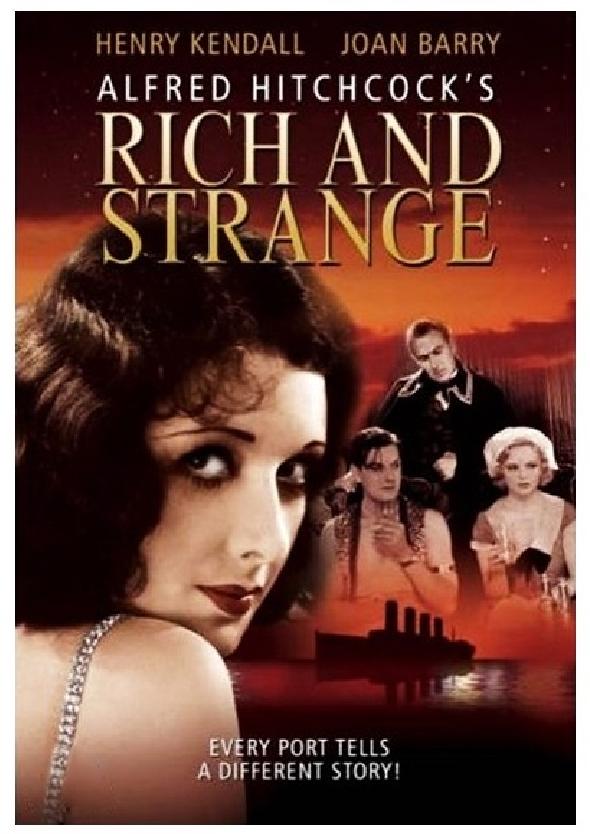Introduction:
“Rich and Strange” (1931), directed by the iconic Alfred Hitchcock, stands as a unique entry in the legendary director’s filmography. Departing from his typical suspenseful narratives, this romance/comedy film showcases Hitchcock’s versatility and early experimentation with genres. In this extensive review, we will delve into the narrative intricacies, character dynamics, comedic brilliance, and the enduring charm of “Rich and Strange,” shedding light on its lesser-known but distinctive place in Hitchcock’s illustrious career.
Plot Synopsis:
The film revolves around the lives of a married couple, Fred Hill (Henry Kendall) and Emily Hill (Joan Barry), who find themselves unexpectedly coming into wealth. The sudden windfall leads them on a whimsical and exotic journey, taking them from the confines of their ordinary lives to the adventures of the high seas. As the couple encounters a series of eccentric characters and navigates the challenges of newfound wealth, “Rich and Strange” unfolds as a quirky exploration of love, desire, and the transformative power of extraordinary experiences.
Character Dynamics:
“Rich and Strange” introduces audiences to a charming yet ordinary couple, portrayed by Henry Kendall and Joan Barry. The chemistry between Kendall and Barry serves as the emotional anchor of the film, capturing the nuances of a relationship undergoing both external and internal transformations. The quirky encounters with eccentric characters add a comedic dimension to the narrative, creating a blend of romance and humor that distinguishes the film from Hitchcock’s more suspenseful works.
Comedic Brilliance:
Hitchcock’s venture into the romance/comedy genre with “Rich and Strange” showcases his early command of comedic elements and narrative innovation.
- Fish-Out-of-Water Humor:
- The film employs fish-out-of-water humor as the couple, accustomed to their ordinary lives, is thrust into a world of luxury and adventure. The juxtaposition of the Hills’ reactions to their newfound wealth and the exotic locales they visit provides ample comedic moments.
- Satirical Exploration of Social Class:
- “Rich and Strange” satirically explores the impact of social class on human behavior. The couple’s encounters with the upper crust of society and the challenges they face in adapting to their new status add a satirical layer to the comedic elements, reflecting Hitchcock’s keen observation of human dynamics.
- Visual Gags and Set Pieces:
- Hitchcock incorporates visual gags and memorable set pieces to infuse humor into the narrative. From the chaotic scenes aboard the ship to the comedic misunderstandings between the characters, the film embraces a lighthearted tone while maintaining Hitchcock’s signature visual flair.
- Transformational Journey:
- The comedic brilliance of “Rich and Strange” lies in its ability to use humor as a vehicle for personal transformation. As the Hills navigate the challenges of their extraordinary journey, the film explores how humor and adventure can reshape perspectives and relationships.
Enduring Charm:
While “Rich and Strange” may not be as widely celebrated as some of Hitchcock’s suspense classics, its enduring charm lies in its departure from the director’s typical genre conventions. The film provides a glimpse into Hitchcock’s early exploration of comedic storytelling, demonstrating his adaptability and willingness to experiment with different tones and themes.
Critical Reception and Contemporary Perspectives:
Upon its release, “Rich and Strange” received mixed reviews from critics who were uncertain about Hitchcock’s departure from the suspense genre. In contemporary analysis, the film is revisited with a fresh perspective that appreciates its comedic and satirical elements, recognizing it as a unique and often overlooked gem in Hitchcock’s diverse filmography.
Conclusion:
“Rich and Strange” (1931) stands as a testament to Alfred Hitchcock’s versatility and early experimentation with genres outside his typical suspenseful milieu. The film’s quirky blend of romance, comedy, and satire showcases Hitchcock’s ability to navigate diverse storytelling landscapes. While it may not enjoy the same level of recognition as some of Hitchcock’s more iconic works, “Rich and Strange” remains a delightful cinematic journey that adds a distinctive touch to the director’s expansive and influential career. As a charming outlier in the Hitchcockian canon, the film invites audiences to explore the lighter side of the master of suspense while savoring the enduring charm of a romance/comedy that defies expectations.
